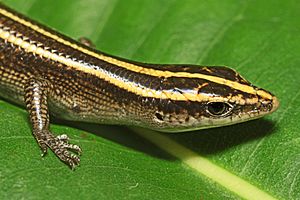Dark-bellied copper-striped skink facts for kids
Quick facts for kids Dark-bellied copper-striped skink |
|
|---|---|
 |
|
| In Samoa | |
| Conservation status | |
| Scientific classification | |
| Genus: |
Emoia
|
| Species: |
impar
|
| Synonyms | |
|
Lygosoma impar Werner, 1898 |
|
The dark-bellied copper-striped skink (scientific name: Emoia impar) is a type of skink, which is a kind of lizard. It is also known as the azure-tailed skink because of its pretty tail. This skink lives across many islands in the Pacific Ocean, especially in Polynesia and Micronesia.
Even though it is common in these areas, the Emoia impar faces some challenges. Its home is shrinking due to habitat loss. It is also threatened by invasive species, which are plants or animals that are not native to an area and can harm the local wildlife. Rising sea levels from global warming also threaten the skink's island homes. This skink used to live in the Hawaiian Islands, likely brought there by early Polynesian travelers. However, it is no longer found there, possibly because of an invasive insect called the big-headed ant.
Contents
What is a Skink?
Skinks are a large group of lizards. They are often mistaken for snakes because many skinks have long, smooth bodies and short legs. Some skinks even have no legs at all! They are found all over the world, especially in warmer climates.
Skink Features
Skinks usually have shiny, smooth scales. These scales often overlap, making their bodies look sleek. They have small heads and often have clear scales over their eyes, like a built-in pair of goggles. This helps them see even when they are underground.
Where Skinks Live
Most skinks live on the ground, hiding under rocks, logs, or in leaf litter. Some skinks can even burrow into the soil. They are often shy and quick, making them hard to spot in the wild. Skinks are important parts of their ecosystems. They help control insect populations and are also a food source for other animals.
The Emoia impar Skink
The Emoia impar is a small to medium-sized skink. It gets its common names from its appearance. The "dark-bellied" part refers to its underside. The "copper-striped" part describes the stripes along its body. Its tail can sometimes have a bluish or "azure" color, especially when it is young.
Where it Lives
This skink is found on many islands across the Pacific. Its range includes places like Samoa, the Cook Islands, Fiji, French Polynesia, and the Marshall Islands. It prefers to live in forests and coastal areas. It often hides among plants and fallen leaves.
Skink Diet
Like many skinks, the Emoia impar is an insectivore. This means it mostly eats insects and other small invertebrates. It helps to keep insect populations in check. This skink is an active hunter, using its keen eyesight to find prey.
Threats to the Skink
Even though the Emoia impar is common, it faces serious threats. These threats are mostly caused by human activities and changes to the environment. Understanding these dangers helps us protect this interesting lizard.
Habitat Loss
One major threat is the loss of its natural home. As human populations grow on Pacific islands, more land is used for buildings, farms, and roads. This destroys the forests and coastal areas where the skink lives. When their habitat disappears, skinks have fewer places to live, hunt, and reproduce.
Invasive Species
Another big problem is invasive species. These are animals or plants that are brought to an island, often by accident. They can outcompete native species for food and space. They can also prey on native animals. For the Emoia impar, one major invasive threat is the big-headed ant (scientific name: Pheidole megacephala). These ants are aggressive and can eat skink eggs or young skinks. They might have caused the skink to disappear from Hawaii.
Climate Change
Global warming is causing sea level rise. Many Pacific islands are low-lying, meaning they are not very high above the ocean. As sea levels rise, coastal areas where the skink lives can become flooded. This reduces the amount of land available for the skinks. Extreme weather events, which are becoming more common with climate change, can also harm skink populations.
Protecting the Emoia impar
Protecting the Emoia impar and other island species is important. This involves managing habitats and controlling invasive species. It also means addressing the bigger issue of climate change.
Conservation Efforts
Conservation groups and local communities are working to protect these skinks. This includes restoring damaged habitats. It also means trying to control invasive species like the big-headed ant. Educating people about the importance of native wildlife is also a key part of conservation.
What You Can Do
Even young people can help protect animals like the Emoia impar. Learning about these creatures is a great first step. Supporting efforts to reduce pollution and combat climate change also makes a difference. Every small action can help protect our planet's amazing biodiversity.
See also
 In Spanish: Emoia impar para niños
In Spanish: Emoia impar para niños


